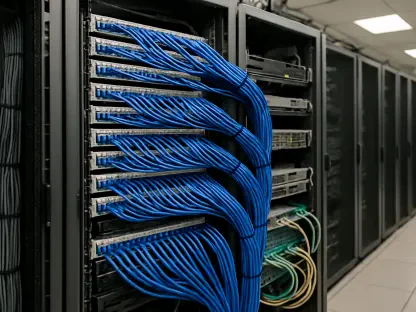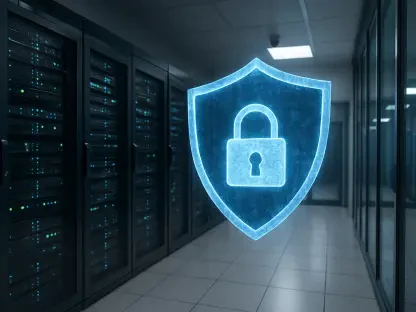Introduction
In an era where data breaches can cost organizations millions and compromise critical infrastructure, the quest for robust cybersecurity in data centers has never been more urgent, with over 80% of enterprises reporting an increase in cyber threats targeting their systems. This staggering reality underscores the pressing need for effective security frameworks that can adapt to the sprawling complexity of modern IT environments. The shift from traditional models to innovative approaches has sparked intense debate, particularly around the decline of Cybersecurity Mesh Architecture (CSMA) and the ascent of Security Service Edge (SSE) as a viable solution. This FAQ article aims to address the most critical questions surrounding these paradigms, offering clear insights into their strengths, weaknesses, and implications. Readers can expect a detailed exploration of why one strategy faltered while another gained traction, along with practical guidance for data center operators navigating this evolving landscape.
The focus here is on breaking down complex concepts into accessible answers, ensuring that both technical and strategic aspects are covered comprehensively. By delving into the challenges of fragmented security tools, the theoretical appeal versus practical limitations of certain frameworks, and the targeted benefits of emerging solutions, this piece provides a roadmap for understanding current trends. Ultimately, the goal is to equip stakeholders with the knowledge needed to make informed decisions about securing their digital assets in an increasingly hostile cyber environment.
Key Questions or Key Topics
What Is Cybersecurity Mesh Architecture (CSMA) and Why Was It Introduced?
CSMA emerged as a visionary concept in the cybersecurity realm, designed to tackle the chaos of disparate security tools in sprawling IT ecosystems. Promoted as a transformative approach around 2025, it aimed to create an interconnected web of security solutions that could share contextual data across platforms, enhancing threat detection and policy enforcement. The motivation behind its introduction stemmed from the growing complexity of data centers managing diverse systems—from cloud environments to legacy mainframes—where no single tool could provide comprehensive protection.
The primary appeal of this framework lay in its promise to correlate signals from various sources, such as firewalls and cloud logs, to identify threats more swiftly and accurately. Additionally, it sought to enable unified policy management, allowing organizations to apply consistent rules across email, SaaS applications, and other systems. However, despite its conceptual strength, the approach faced significant hurdles in translating theory into actionable outcomes, setting the stage for a deeper examination of its shortcomings.
Why Did CSMA Fail to Gain Widespread Adoption?
The decline of CSMA can be attributed to its inability to overcome substantial practical barriers, despite its innovative design for unifying security tools. One major issue was the immense complexity involved in integrating dozens of specialized solutions through custom interfaces, a task that often proved cumbersome and error-prone. Data center operators found that maintaining such a system demanded extensive resources and expertise, far beyond what many organizations could allocate.
Moreover, the operational fragility of the automation frameworks supporting CSMA posed another critical challenge, as updates or changes frequently disrupted functionality. This unreliability, coupled with the absence of documented success stories or real-world implementations, eroded confidence in its viability. As a result, the industry began seeking alternatives that could deliver results without the overwhelming overhead that this mesh approach required.
What Is Security Service Edge (SSE) and How Does It Differ from CSMA?
SSE represents a more focused and pragmatic shift in cybersecurity strategy, specifically targeting network perimeter security for data centers. Unlike the broad scope of CSMA, which attempted to integrate all aspects of security, SSE consolidates key functions such as firewalls, secure web gateways, and data loss prevention into unified platforms. This streamlined approach reduces the integration burden, making it a more accessible option for organizations aiming to enhance their defenses.
The distinction lies in SSE’s narrower focus, prioritizing actionable coherence over comprehensive unification. By harmonizing analytics and policy enforcement within network security, it offers measurable benefits without attempting to address unrelated domains like vulnerability management. This targeted nature has positioned SSE as a practical stepping stone for data center operators looking to improve security without the exhaustive efforts demanded by broader frameworks.
What Are the Main Benefits of SSE for Data Centers?
SSE brings several tangible advantages to data centers, particularly in simplifying the management of network security. One key benefit is the consolidation of essential tools into a single platform, which minimizes the complexity of handling multiple disparate systems. This unification not only streamlines operations but also enhances visibility into potential threats at the network perimeter, enabling quicker responses to incidents.
Another significant advantage is the reduction in integration challenges, as SSE platforms are designed to work cohesively without the need for extensive custom configurations. This ease of deployment allows organizations to achieve immediate operational improvements, a stark contrast to more resource-intensive alternatives. For data centers under constant pressure to maintain uptime and security, these benefits translate into both cost savings and stronger protection against evolving cyber risks.
How Can Data Center Operators Strategically Implement SSE?
Implementing SSE effectively requires a strategic mindset that acknowledges the inherent complexity of IT environments while focusing on achievable goals. Data center operators should begin by identifying specific network security needs, ensuring that the chosen SSE platform aligns with those priorities. This targeted approach avoids overextending resources and maximizes the impact of the deployment on critical areas like perimeter defense.
Additionally, setting clear expectations about the scope of SSE is vital, recognizing that it does not address all cybersecurity facets but excels in specific domains. Operators are encouraged to complement this with selective integration of other tools where necessary, maintaining a balance between consolidation and specialization. By viewing SSE as a practical step toward broader security goals, organizations can build a scalable architecture that adapts to future demands.
What Lessons Can Be Learned from CSMA’s Challenges for Future Cybersecurity Strategies?
The struggles of CSMA offer valuable insights for shaping future cybersecurity initiatives, emphasizing the importance of balancing ambition with feasibility. One critical lesson is the need to prioritize practical implementation over theoretical ideals, ensuring that proposed solutions can be realistically deployed within existing resource constraints. This perspective helps avoid the pitfalls of overcomplicating security architectures that ultimately fail to deliver.
Furthermore, the experience highlights the value of incremental progress, suggesting that smaller, focused improvements often yield better results than sweeping overhauls. Future strategies should draw on CSMA’s principles, such as cross-platform correlation, as guiding philosophies rather than rigid mandates. By learning from these challenges, the industry can develop more resilient and adaptable frameworks tailored to the real-world needs of data centers.
Summary or Recap
This article addresses pivotal questions surrounding the transition from CSMA to SSE in data center cybersecurity, shedding light on the reasons behind one framework’s decline and another’s rise. Key points include the impracticality of CSMA due to integration complexities and operational fragility, contrasted with SSE’s focused approach to network security consolidation. The benefits of SSE, such as simplified management and reduced overhead, stand out as immediate advantages for operators seeking effective solutions.
The strategic guidance provided underscores the importance of accepting IT complexity while pursuing targeted improvements through SSE. Lessons from CSMA’s shortcomings further inform future approaches, advocating for practicality and incremental progress. For those looking to delve deeper into these topics, exploring industry reports on network security trends or case studies on SSE deployments can offer additional context and actionable insights.
Conclusion or Final Thoughts
Reflecting on the journey from ambitious cybersecurity frameworks to more grounded solutions, it becomes evident that adaptability is key to addressing the dynamic threats facing data centers. The shift to SSE marks a turning point, offering a practical path that many organizations have embraced to bolster their defenses without overextending their capabilities. This evolution highlights a broader industry realization that success often lies in focused, incremental steps rather than overarching ideals.
Looking ahead, data center operators are encouraged to evaluate their specific security needs and consider how SSE can fit into their broader strategy. Experimenting with pilot programs or engaging with vendors for tailored solutions emerges as a viable next step to test the waters. By staying attuned to emerging trends and remaining flexible in their approach, stakeholders can better position themselves to tackle future challenges in an ever-changing cyber landscape.









